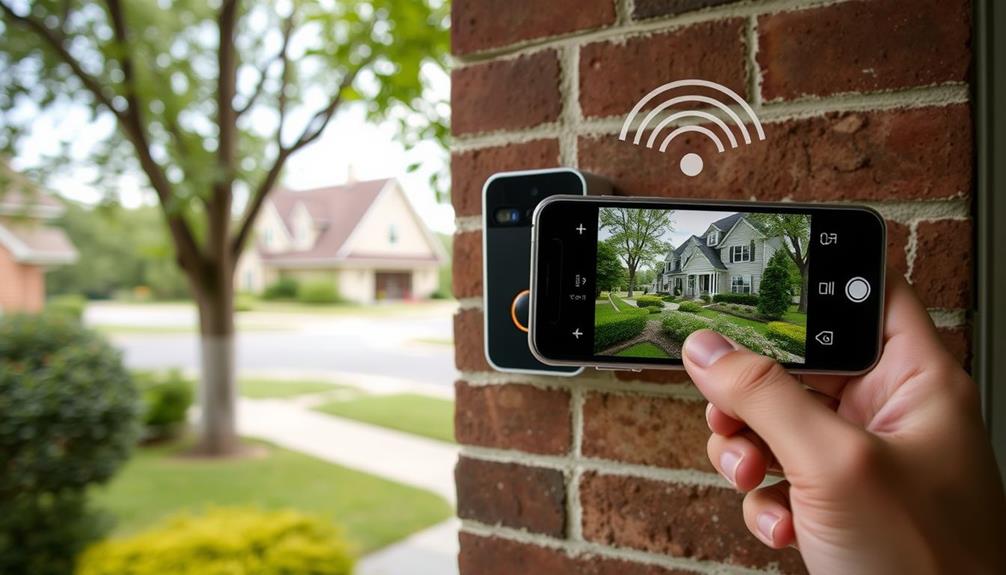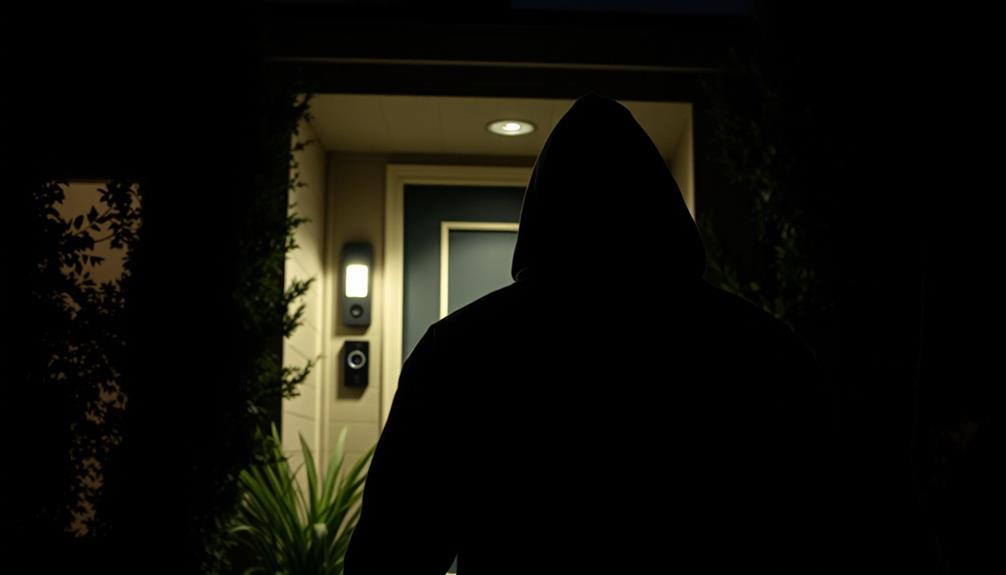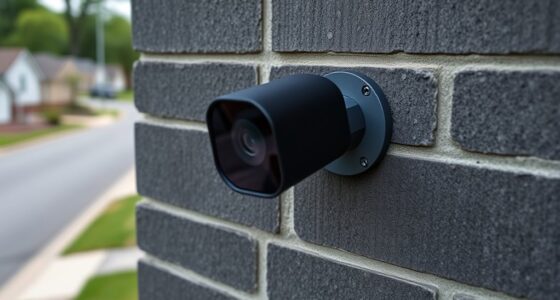To decrease motion sensitivity on your Ring Doorbell, open the Ring app and select your device. Navigate to "Motion Settings" and adjust the sensitivity slider to a lower setting. This will help filter out minor movements. You can also configure specific motion zones to focus detection on critical areas while excluding distractions like busy streets. Consider enabling the "People Only" mode to minimize alerts from non-human movement. Regularly check and update your app for the best performance. With a few tweaks, you can fine-tune your alerts for a more tailored experience that fits your needs. More options await!
Key Takeaways
- Open the Ring app, select your device, and navigate to "Motion Settings" to access the sensitivity slider.
- Lower the sensitivity level to reduce alerts from minor movements, adjusting further if necessary.
- Create and customize motion zones to focus detection on critical areas and minimize false alerts.
- Enable "Advanced Motion Detection" for optimal performance and save all changes to apply new settings.
Understanding Motion Sensitivity
Understanding Motion Sensitivity
Motion sensitivity on your Ring doorbell lets you customize how responsive it's to movement, helping you control the number of alerts you receive.
By adjusting the motion sensitivity settings, you can filter out minor movements that might trigger unnecessary alerts, which is especially useful in busy environments.
The Ring app allows you to set the sensitivity to low, medium, or high, ensuring you find the right balance for your specific needs.
Additionally, you can enhance your home security by integrating modern technology like garage door openers, which also offer smart features for remote access.
When you lower the sensitivity, you may still receive alerts due to environmental factors like wind or passing vehicles.
That's why it's important to regularly monitor and make adjustments based on your surroundings.
For example, if you live near a busy street, a lower sensitivity might help reduce the number of alerts caused by traffic. Conversely, if you're in a quieter area, you might want to increase the sensitivity to capture more activity.
Understanding motion sensitivity is key to optimizing your Ring doorbell's performance.
Accessing Motion Settings
To access the motion settings on your Ring Doorbell, start by opening the Ring app and selecting the device you want to adjust.
It's important to tailor your motion sensitivity, especially considering that security systems can deter potential burglars by 60% increased safety and peace of mind.
From there, you can find the "Motion Settings" option and use the sensitivity slider to customize your alerts.
Don't forget to save your changes to make sure your new settings take effect.
Navigating the Ring App
Open the Ring app and select your Ring Doorbell device to explore the motion settings. Once you've chosen your device, tap on "Motion Settings" to access options for adjusting sensitivity and configuring motion zones.
Here's a quick overview of what you can do:
| Action | Description |
|---|---|
| Adjust Sensitivity | Use the Motion Sensitivity slider to decrease sensitivity. This helps filter out minor movements, reducing unwanted alerts. |
| Save Changes | Don't forget to save changes after adjusting the slider to apply your new settings. |
| Regular Checks | Periodically check motion settings, especially after any significant environmental changes, to guarantee peak performance. |
Adjusting Sensitivity Slider
Access the sensitivity slider in the Ring app to fine-tune how your doorbell responds to movement. Start by opening the Ring app and selecting your doorbell device. Once you're in, navigate to the "Motion Settings" section. Here, you'll find the options to adjust Motion Sensitivity.
For enhanced indoor monitoring, consider integrating air quality improvement strategies alongside your motion detection to elevate overall home safety.
Use the slider to lower the sensitivity if you're receiving too many alerts triggered by minor movements, like passing cars or swaying branches. Sliding it down will help minimize unnecessary notifications, allowing you to focus on more significant events.
Keep in mind that you can always monitor the performance after making these adjustments. If you find that you're still getting too many alerts, feel free to return and tweak the slider further.
Once you're satisfied with the new sensitivity level, don't forget to save changes to guarantee your adjustments take effect. Regularly revisiting these settings can help you maintain ideal alert management tailored to your specific needs.
Saving Settings Changes
After adjusting the sensitivity slider, it's important to save your changes to confirm they take effect. If you don't save, your adjustments won't be applied, and you may continue receiving unnecessary alerts. Here's how to make sure your settings are saved:
- Open the Ring app: Select your doorbell device from the dashboard to access Motion Settings.
- Navigate to Motion Settings: Once in the device settings, find the section labeled "Motion Settings" to view your adjustments.
- Select the save option: After adjusting the sensitivity slider to your preferred level, be certain to click the save option at the bottom of the screen.
Regularly checking and adjusting these settings is essential for peak performance based on your environment. If you notice that alerts are still triggering too frequently, consider revisiting the Motion Settings to fine-tune the sensitivity slider further.
Adjusting Motion Sensitivity Slider

To decrease motion sensitivity on your Ring Doorbell, simply select the device in the Ring app and head to the "Motion Settings" section.
Here, you'll find the sensitivity slider that allows you to adjust the level of motion sensitivity. A well-functioning system is vital for maintaining a secure home, and understanding how to customize your device can make all the difference in your experience with home security. This is similar to how you'd approach key factors in choosing a home cleaning service where adjustments are made based on specific needs.
To reduce the number of alerts triggered by minor movements, move the sensitivity slider left towards "Low." This adjustment helps filter out unnecessary notifications, so you only receive alerts for more significant motion events.
After you've made your adjustments, don't forget to save your changes to apply the new settings.
It's essential to regularly monitor your alerts after adjusting the sensitivity slider. This way, you can find the ideal balance that works for your specific environment. If you still find yourself getting too many alerts, consider moving the slider further left. Conversely, if you notice you're missing important notifications, you might want to increase the sensitivity slightly.
With the right adjustments, you can tailor your Ring Doorbell's motion sensitivity to fit your needs perfectly.
Configuring Motion Zones
Configuring motion zones is a key step in fine-tuning your Ring doorbell's sensitivity.
You can set up specific areas to monitor, adjust their size, and minimize false alerts from passing traffic or pedestrians.
For example, consider using a mix of settings similar to those used in well-draining soil essential for your garden, as it can help create a balanced approach to monitoring.
Let's explore how to optimize these settings for better performance.
Setting Up Motion Zones
Access the Ring app and select your device to start setting up your motion zones. This process enables you to create customizable motion areas tailored to your needs.
First, verify that Advanced Motion Detection is enabled for the best results. By understanding how to configure your settings effectively, you can enhance your security measures and improve your overall user experience, which is vital for maintaining engagement. For more insights, check out strategies for increasing topical authority.
Next, follow these steps to set up your motion zones:
- Create Zones: You can create up to three different motion zones to focus on specific areas, like your front yard or porch.
- Adjust the Size: Use the app's interface to drag the corners of each zone and cover the areas you want to monitor accurately.
- Save Settings: Once you've configured your zones, save your settings to activate them.
Adjusting Zone Size
You can easily adjust the size of your motion zones within the Ring app to focus on specific areas and minimize unnecessary alerts.
Start by accessing the Ring app and selecting your doorbell device from the dashboard. Once there, navigate to the "Motion Settings" section. Be certain to enable "Advanced Motion Detection" if it isn't already active. This feature is particularly important in light of the recent increased scrutiny on cybersecurity measures due to significant disruptions in global networks. Additionally, you can fine-tune the precise areas where motion is detected by adjusting the zones within the **Motion Zones** section. This can help minimize false alerts caused by external movement outside your desired coverage area. For those curious about how to disable Ring doorbell altogether, simply switch off the **Motion Detection** feature in the same settings area or turn off **Snooze Motion** to pause alerts temporarily.
Now, you can customize your motion zones. Tap on "Create Motion Zone" to define the areas you want to monitor. You have the option to create up to three customizable motion zones. Use the resizing handles on the motion zone outline to increase or decrease the detection area. This way, you can guarantee that the zones focus on specific locations, like your front porch or driveway.
After customizing your motion zones, don't forget to save your changes. This will apply the new motion zone settings and help reduce unnecessary alerts from outside activity.
Minimizing False Alerts
Customize your motion zones to effectively limit detection to specific areas, reducing the chance of false alerts from outside movements.
By using the Ring app, you can create up to three customizable motion zones, allowing you to focus on areas that matter most to you. This is particularly important as understanding the impacts of technology on personal security can enhance your overall safety measures security tips.
Here's how to get started:
- Access the Ring app: Open the app and verify that advanced motion detection is activated for your doorbell model.
- Define your zones: Resize and reposition motion zones to include walkways or porches while excluding areas with frequent outside motion, like streets or sidewalks.
- Activate the Package Zone: If you often receive deliveries, enable the Package Zone feature to receive alerts specifically for package deliveries, further minimizing irrelevant motion alerts.
Setting Up Package Zone

To effectively set up a Package Zone on your Ring Doorbell, simply open the Ring app and navigate to the Motion Settings for your device.
Once you're in the Motion Settings, look for the option to create a Package Zone. This feature is specifically designed to detect packages and sends alerts when items approximately ten inches or larger are detected.
To enhance your setup, consider how environmental factors might affect the performance of your doorbell, as certain smells or distractions can influence motion detection understanding Toxicity to Cats From Ferns.
You can customize the size of the Package Zone to improve detection accuracy based on your delivery area. Adjusting the dimensions guarantees that your Doorbell focuses on the right area, making it more effective in identifying packages while minimizing false alerts from other motion.
After setting up the Package Zone, you can also modify your notification preferences for package alerts. This allows you to choose whether to receive alerts for detected deliveries, helping you stay informed without unnecessary distractions.
Customizing Smart Alerts
Smart Alerts enhance your Ring Doorbell experience by focusing notifications on human detection, reducing unnecessary alerts from pets or passing cars. By leveraging advanced technology, such as AI-driven solutions, you can achieve a more efficient monitoring system.
To customize these alerts, follow these steps:
- Open the Ring app and navigate to your specific device's settings.
- Access Motion Settings, where you'll find the option for Smart Alerts. This feature allows you to minimize notifications triggered by non-human motion.
- Adjust notification preferences so that recording remains active while muting alerts for non-human activities.
You can also set distinct Smart Alert settings for each motion zone, tailoring notifications based on the areas that matter most to you.
After making your adjustments, don't forget to save your changes to guarantee the updated settings take effect immediately.
This customization not only enhances your overall alert experience but also helps you stay informed about genuine activities around your property without the distraction of irrelevant notifications.
Regular App Updates

Staying current with regular app updates can greatly enhance your Ring Doorbell's motion sensitivity settings and overall performance. These updates provide critical improvements, including advanced algorithms for motion detection that can refine your sensitivity preferences. By keeping your app updated, you'll guarantee that you're benefiting from the latest features and enhancements that Ring offers.
Regular app updates also help fix bugs that can lead to false alerts, which are often a result of sensitivity issues. When you receive fewer false alerts, you'll have a smoother experience using your Ring Doorbell. The app typically prompts you when a new version is available, making it easy to stay on top of updates.
To maximize convenience, consider enabling automatic updates on your device. This way, you can verify you're always utilizing the most current version of the Ring app, which may include improvements to motion sensitivity configurations.
Ultimately, maintaining ideal functionality is crucial for achieving the best performance from your Ring Doorbell, so don't overlook the importance of regular app updates. They're a simple yet effective way to enhance your security experience.
Troubleshooting Common Issues
When you encounter issues with motion sensitivity on your Ring Doorbell, it's essential to troubleshoot effectively to guarantee peak performance. Here are three steps to help you adjust your settings and reduce unnecessary alerts:
- Check Motion Settings: Open the Ring app, select your device, and navigate to Motion Settings. Here, you can adjust the sensitivity slider to a lower setting to filter out minor movements that may trigger alerts.
- Observe Your Environment: Take a moment to assess your surroundings. If there are pets, foliage, or other moving objects, consider lowering the motion sensitivity further. Tailoring your settings based on the environment can greatly reduce false alerts.
- Save Changes: After making adjustments, make sure you save your changes. This step is essential to apply the new settings effectively to your device.
Regularly reviewing and adjusting the motion sensitivity based on your environment can help maintain ideal performance and minimize interruptions. By following these steps, you'll enhance your Ring Doorbell experience while keeping unwanted alerts at bay.
User Community Insights

Many users share valuable insights on how to fine-tune motion sensitivity for their Ring Doorbell, often highlighting practical adjustments that have proven effective in reducing unnecessary alerts.
One common suggestion is adjusting settings in the Ring app to a lower motion sensitivity level, which can greatly decrease false alarms triggered by minor movements.
Community insights also emphasize the importance of configuring specific motion zones. By excluding areas with constant motion—like busy roads or swaying trees—you can refine detection and avoid alerts for other motion that doesn't concern you.
Many users recommend a gradual adjustment approach for finding the best balance in your unique environment. It's wise to monitor performance regularly, as factors like weather conditions and nearby activity can impact effectiveness.
Additionally, some users have noticed that keeping the Ring app updated can lead to better motion detection performance and fewer sensitivity-related issues.
Frequently Asked Questions
How to Reduce Ring Motion Sensitivity?
To reduce motion sensitivity, start by accessing your device settings in the app.
Locate the Motion Settings section and adjust the sensitivity slider to a lower level. This'll help minimize alerts from minor movements.
You can also set specific Motion Zones to focus detection on important areas, ignoring less significant motion outside them.
Regularly check and tweak these settings based on environmental changes to guarantee you get the most relevant notifications.
Can You Adjust Motion Sensor on Ring Doorbell?
Absolutely, adjusting the motion sensor on your Ring Doorbell is a breeze!
By diving into the Ring app, you can easily explore the Motion Settings feature.
With a simple slide, you can set the sensitivity from low to high, tailoring your alerts to your environment.
Just remember to save your settings afterward.
Regularly revisiting these adjustments can help you fine-tune your experience, ensuring you get alerts that matter without the unnecessary noise.
How Do I Turn off the Motion Sensor on My Ring Doorbell?
To turn off the motion sensor on your Ring Doorbell, open the Ring app and select your device from the dashboard.
Go to the "Motion Settings" section and toggle off "Motion Alerts" to stop notifications.
If you want, you can also adjust the "Motion Zones" to exclude areas where you don't need detection.
For a temporary solution, activate "Disarm Mode" to pause motion detection for a specific time period.
How to Change Motion Alerts on Ring?
Isn't it frustrating when your doorbell buzzes for every passing car?
To change motion alerts on your Ring, open the app and tap on your device.
Go to "Motion Settings" and adjust the alerts to your preference.
You can choose to receive alerts only for specific zones or adjust the sensitivity.
Don't forget to save your changes!
Monitor the alerts for a few days to see if you're happier with the new settings.
Conclusion
In the world of your home, your Ring Doorbell acts like a vigilant guardian.
By fine-tuning its motion sensitivity, you can guarantee it only alerts you to what truly matters, like a wise sentinel who knows the difference between a fleeting shadow and a real threat.
Embrace these adjustments, and you'll create a safer, more peaceful environment, allowing you to focus on life's precious moments without the distractions of unnecessary notifications.
Your home deserves that tranquility.









